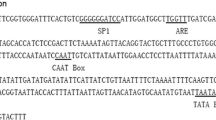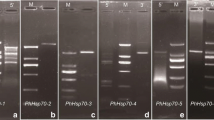Abstract
Heat shock proteins are ubiquitous and highly conserved. Recently they have become implicated in the import of proteins into organelles. All the heat shock genes characterized to date, however, are known or assumed to be encoded in the nuclear genome even if the corresponding protein can be localised in the mitochondrion or chloroplast. In contrast, we identify here an hsp70 gene in the unicellular chromophytic alga Pavlova lutherii which is located on the chloroplast genome. Localisation of this gene to the chloroplast chromosome is confirmed by Southern blot analysis and pulse-field gel electrophoresis which also reveals that the length of the P. lutherii chloroplast chromosome is 115 kb. We compare the predicted protein of this hsp70 gene with that of maize and of the analogous proteins in the prokaryotic organisms Escherichia coli and Synechocystis PCC6803. The greatest identity is found with the cyanobacterium Synechocystis PCC6803.
Similar content being viewed by others
References
Bardwell JCA, Craig EA: Major heat shock gene of Drosophila and the Escherichia coli heat-inducible dnaK gene are homologous. Proc Natl Acad Sci USA 81: 848–852 (1984).
Bedbrook JR, Coen DM, Beaton AR, Bogorad L, Rich A: Location of the single gene for the LSU of RUBISCO on the maize chloroplast chromosome. J Biol Chem 254: 905–910 (1979).
Bolivar F, Rodriguez RL, Greene PJ, Betlach MC, Huyneker HL, Boyer HW, Crosa JH, Falkow S: Construction and characterisation of new cloning vehicles. II. A multipurpose cloning system. Gene 2: 95–113 (1977).
Cattolico RA: Chloroplast evolution in algae and land plants. TREE 1: 64–67 (1986).
Chirico WJ, Waters MG, Blobel G: 70K heat shock related proteins stimulate protein translocation into microsomes. Nature 332: 805–810 (1988).
Chitnis PR, Nelson N: Molecular cloning of the genes encoding two chaperone proteins of the cyanobacterium Synechocystis sp. PCC6803. J Biol Chem 266: 58–65 (1991).
Cole RA, Williams KL: Insertion of transformation vector DNA into different chromosomal sites of Dictyostelium discoideum as determined by pulse field gel electrophoresis. Nucl Acids Res 16: 4891–4902 (1988).
Craig EA, Kramer J, Shilling J, Werner-Washburne M, Holmes S, Kosic-Smithers J, Nicolet CM: SSC1, an essential member of the yeast hsp70 multigene family, encodes a mitochondrial protein. Mol Cell Biol 9: 3000–3008 (1989).
Douglas SE, Murphy CA, Spencer DF, Gray MW: Cryptomonad algae are evolutionary chimaeras of two phylogenetically distinct unicellular eukaryotes. Nature 350: 148–151 (1991).
Gibbs SP: The chloroplast of Euglena has evolved from symbiotic green algae. Can J Bot 56: 2883–2889 (1978).
Grossman A, Manodori A, Snyder D: Light harvesting proteins of diatoms: Their relationship to the chlorophyll a/b binding proteins of higher plants and their mode of transport into plastids. Mol Gen Genet 224: 91–100 (1990).
Hemmingsen SM, Woolford C, van der Vies SM, Tilly K, Dennis DT, Georgopoulos CP, Hendrix RW, Ellis RJ: Homologous plant and bacterial proteins chaperone oligomeric protein assembly. Nature 333: 330–334 (1988).
Higgins DG, Sharp PM: Fast and sensitive multiple sequence alignments on a microcomputer. CABIOS 5: 151–153 (1989).
Hunt C, Morimoto RI: Conserved features of eukaryotic hsp70 genes revealed by comparison with the nucleotide sequence of human hsp70. Proc Natl Acad Sci USA 82: 6455–6459 (1985).
Kang P-J, Ostermann J, Schilling J, Neupert W, Craig EA, Pfanner N: Requirement for hsp70 in the mitochondrial matrix for translocation and folding of precursor proteins. Nature 348: 137–143 (1990).
Lindquist S, Craig EA: The heat-shock proteins. Annu Rev Genet 22: 631–677 (1988).
McFadden GI: Evidence that cryptomonad chloroplasts evolved from photosynthetic eukaryotic endosymbionts. J Cell Sci 95: 303–308 (1990).
Maniatis T, Fritsch EF, Sambrook J: Molecular Cloning: A Laboratory Manual. Cold Spring Harbor Laboratory, Cold Spring Harbor, NY (1982).
Marshall JS, DeRocher AE, Keegstra K, Vierling E: Identification of heat shock protein hsp70 homologues in chloroplasts. Proc Natl Acad Sci USA 87: 374–378 (1990).
Neupert W, Hartl F-U, Craig EA, Pfanner N: How do polypeptides cross the mitochondrial membranes? Cell 63: 447–450 (1990).
Ohyama K, Fukuzawa H, Kohchi T, Shirai H, Sano T, Sano S, Umesono K, Shiki Y, Takeuchi M, Chang Z, Aota S-I, Inokuchi H, Ozeki H: Chloroplast gene organization deduced from complete sequence of liverwort Marchantia polymorpha chloroplast DNA. Nature 322: 572–574 (1986).
Powell MJ, Watts FZ: Isolation of a gene encoding a mitochondrial hsp70 from Schizosaccharomyces pombe. Gene 95: 105–110 (1990).
Provasoli L: Growing marine seaweeds. In: DeVirville D, Feldman J (eds) Proc Int Seaweed Symp 4: 9–17. Pergamon, Oxford (1963).
Reading DS, Halberg RL, Myers AM: Characterization of the yeast HSP60 gene coding for a mitochondrial assembly factor. Nature 337: 655–659 (1989).
Rochaix JD: Isolation of chloroplast DNA from Chlamydomonas reinhardtii. In: Edelman M, Hallick RB, Chua NH (eds) Methods in Chloroplast Molecular Biology, pp. 295–300. Elsevier Biomedical Press, Amsterdam (1982).
Rochester DE, Winer JA, Shah DM: The structure and expression of maize genes encoding the major heat shock protein, hsp70. EMBO J 5: 451–458 (1986).
Sanger F, Coulson AR, Barell BG, Smith AJH, Roe BA: Cloning in single-stranded bacteriophage as an aid to rapid DNA sequencing. J Mol Biol 143: 161–178 (1980).
Shinozaki K, Ohme M, Tanaka M, Wakasugi T, Hayashida N, Matsubayashi T, Zaita N, Chungwongse J, Obokata J, Yamaguchi-Shinozaki K, Ohto C, Torazawa K, Meng BY, Sugita M, Deno H, Kamogashira T, Yamada K, Kusada J, Takaiwa F, Kato A, Tohdoh N, Shimada H, Sugiura M: The complete nucleotide sequence of the tobacco chloroplast genome: its gene organization and expression. EMBO J 5: 2043–2049 (1986).
von Heijne G, Steppuhn J, Herrman RG: Domain structure of mitochondrial and chloroplast targeting peptides. Eur J Biochem 180: 535–545 (1989).
Whatley JM, Whatley FR: Chloroplast evolution. New Phytol 87: 233–247 (1981).
Winter J, Wright R, Duck N, Gasser C, Fraley E, Shah D: The inhibition of petunia hsp70 mRNA processing during CdCl2 stress. Mol Gen Genet 211: 315–319 (1988).
Yanisch-Perron C, Viera J, Messing J: Improved M13 phage cloning vectors and host strains: nucleotide sequences of the M13 mp18 and pUC19 vectors. Gene 33: 103–119 (1985).
Author information
Authors and Affiliations
Rights and permissions
About this article
Cite this article
Scaramuzzi, C.D., Stokes, H.W. & Hiller, R.G. Heat shock Hsp70 protein is chloroplast-encoded in the chromophytic alga Pavlova lutherii . Plant Mol Biol 18, 467–476 (1992). https://doi.org/10.1007/BF00040663
Received:
Accepted:
Issue Date:
DOI: https://doi.org/10.1007/BF00040663




